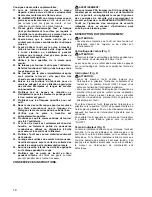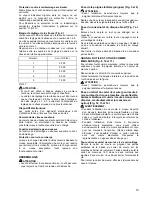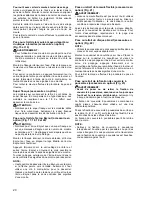
11
Grinding and sanding operation (Fig. 24)
ALWAYS hold the tool firmly with one hand on housing
and the other on the side handle. Do not touch the metal
parts. Turn the tool on and then apply the wheel or disc to
the workpiece.
In general, keep the edge of the wheel or disc at an angle
of about 15° to the workpiece surface.
During the break-in period with a new wheel, do not work
the grinder in the B direction or it will cut into the work-
piece. Once the edge of the wheel has been rounded off
by use, the wheel may be worked in both A and B direc-
tion.
Operation with abrasive cut-off / diamond wheel
(optional accessory) (Fig. 25)
The direction for mounting the lock nut and the inner
flange varies by wheel thickness.
Refer to the table below.
011644
WARNING:
• When using an abrasive cut-off / diamond wheel, be
sure to use only the special wheel guard designed for
use with cut-off wheels. (In some European countries,
when using a diamond wheel, the ordinary guard can
be used. Follow the regulations in your country.)
• NEVER use cut-off wheel for side grinding.
• Do not “jam” the wheel or apply excessive pressure.
Do not attempt to make an excessive depth of cut.
Overstressing the wheel increases the loading and
susceptibility to twisting or binding of the wheel in the
cut and the possibility of kickback, wheel breakage and
overheating of the motor may occur.
• Do not start the cutting operation in the workpiece. Let
the wheel reach full speed and carefully enter into the
cut moving the tool forward over the workpiece surface.
The wheel may bind, walk up or kickback if the power
tool is started in the workpiece.
• During cutting operations, never change the angle of
the wheel. Placing side pressure on the cut-off wheel
(as in grinding) will cause the wheel to crack and break,
causing serious personal injury.
• A diamond wheel shall be operated perpendicular to
the material being cut.
Operation with wire cup brush (optional
accessory) (Fig. 26)
CAUTION:
• Check operation of brush by running tool with no load,
insuring that no one is in front of or in line with brush.
• Do not use brush that is damaged, or which is out of
balance. Use of damaged brush could increase poten-
tial for injury from contact with broken brush wires.
Unplug tool and place it upside down allowing easy
access to spindle. Remove any accessories on spindle.
Thread wire cup brush onto spindle and tighten with sup-
plied wrench. When using brush, avoid applying too
much pressure which causes over bending of wires,
leading to premature breakage.
Operation with wire wheel brush (optional
accessory) (Fig. 27)
CAUTION:
• Check operation of wire wheel brush by running tool
with no load, insuring that no one is in front of or in line
with the wire wheel brush.
• Do not use wire wheel brush that is damaged, or which
is out of balance. Use of damaged wire wheel brush
could increase potential for injury from contact with bro-
ken wires.
• ALWAYS use guard with wire wheel brushes, assuring
diameter of wheel fits inside guard. Wheel can shatter
during use and guard helps to reduce chances of per-
sonal injury.
Unplug tool and place it upside down allowing easy
access to spindle. Remove any accessories on spindle.
Thread wire wheel brush onto spindle and tighten with
the wrenches.
When using wire wheel brush, avoid applying too much
pressure which causes over bending of wires, leading to
premature breakage.
1
2
3
1
4
3
Abrasive cut-off wheel
Diamond wheel
Thickness: Less than 4 mm (5/32")
Thickness: 4 mm (5/32") or more
Thickness: Less than 4 mm (5/32")
Thickness: 4 mm (5/32") or more
22.23 mm (7/8")
22.23 mm (7/8")
22.23 mm (7/8")
22.23 mm (7/8")
1. Lock nut
2. Abrasive cut-off wheel
3. Inner flange
4. Diamond wheel












































